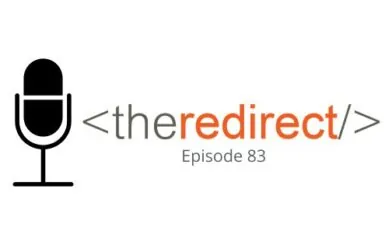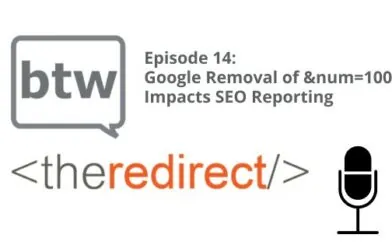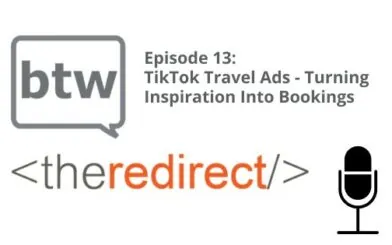Listen now:
Welcome to The Redirect Podcast, where the BlackTruck team shares recent insights and takeaways from the world of search marketing.
In this week’s episode:
- Last click attribution is the default for Google Ads, but it could be killing your campaign’s performance. Having just spent an entire day with the team at Google discussing proper attribution models, we dive into specifics on which model might be right for you; including some questions to ask of those running campaigns for you (begins at 2:24).
- Industry chatter has us excited about seeing more details inside Google My Business Insights. This time the focus is on localized keywords that trigger your business to display in local results (begins at 19:21).
- Plus, long live voice search! Actually, we’re over it and have moved onto conversational AI—have you? (begins at 28:54—and watch your volume for some big enthusiasm at 29:04!)
Attribution Models in Google Ads
On October 17, Patrick was able to attend a Google Partners learning session focusing on PPC and Ads—the Expert Series on Search Attribution.
The primary message of the course was to educate Ads managers to lean away from the conversion attribution model of “last click,” even though it is the default setting. It’s one of those “it’s always been done this way” things, and the industry is working to move away from it. In the beginning, last click was essentially the most effective way to track conversions. But as technology has improved and tracking methods get richer, there are several attribution models available to track where those conversions are coming from, including first click, position based, linear, time decay, and a new method not yet available everywhere: data driven.
These different conversion models will assign weight to different levels in the conversion path, providing greater insights as to what was successful as that initial trigger that started the process toward conversion. This brings more generic keyword phrases to the forefront, rather than specific brand or product-related queries. An example from the learning session was this search string: “great tech gifts” > “highly rated tech gifts” > “Nexus 9 tablet”
In a last click model, “Nexus 9 tablet” gets all the conversion credit. In a first click model, “great tech gifts” gets all the credit.
The other models will show a weighted conversion along the path. Moving backwards towards that first click, conversion rates will increase, as in actuality it was those “top of funnel” searches that triggered the end user on the path to the converting click. Tracing the funnel backwards can clearly show “great tech gifts” as the keyword phrase that led to the conversion.
Attribution Affects Reporting Capabilities
Additionally, there needs to be a change in how you understand reporting when working on a model that is not last click. For example, on a first click model, if the actual conversion action takes place on December 3, but there is a 5 day average conversion window, the credit on the conversion will show in reports as of November 28—therefore existing on the previous month’s report. If you created your November report on December 2, it would not have accurate conversion numbers for the month of November. Google’s recommendation in this case is to conclude reporting no earlier than the 5th of the following month.
The one-day learning session showed there are plenty of advancements happening in the attribution models, and the data driven model will really be able to take this to even another level. With a deeper understanding of how these attribution models work, Ads managers should take time to sit down with all the accounts they manage, dig into each conversion attribution model that is currently set up, and make sure the campaigns are getting the most helpful performance insights from these settings.
Google My Business Insights for Local Search Keywords
We’ve had some internal discussions lately about tools to help with tracking keywords from a local search perspective. While this isn’t exactly a solution for in-depth tracking, it IS a great new(ish) way to gain insight into how people are searching locally, and what queries are surfacing your business in local results—specifically Google’s Local results and Maps.
I saw some industry chatter a while back about how queries were a feature that would be coming soon to the Insights shown in Google My Business. They haven’t been around long; in fact they rolled out to all GMB accounts at the end of August.
If you log into Google My Business and go into the Insights view on the management side, at the very top you’ll now see “Queries used to find your business.” You can view 1 week, 1 month, or 1 quarter’s worth of data. The data will show you the query used, and how many unique users found you through that query.
Google is a little vague on whether a user “finding” you means that you showed up in a local pack or map, or that someone actually clicked on your Google listing. (Here’s what Google says about how customers find your listing.) Google encourages you to write your future ads and posts based on what you see in this data. (Of course, as with all data, use your best judgement…we apparently attracted 21 users via the query “roller coaster near me,” but a lot of the other stuff checked out.)
For now, it appears you can’t export this data directly, but there it can be integrated with Google Data Studio via connectors.
Different From from Search Console Data
Search Engine Land recently shared a contribution from Joy Hawkins called “3 Reasons why Google My Business search queries don’t match Search Console.” She points out that the data is different between the two because Search Console is reporting on traffic from Google My Business, as well as regular ol’ organic search. To be able to discern the two in Search Console, she suggests separating this traffic by using UTM codes for your website on Google My Business.
She also points out that Search Console is reporting on impressions, and Google My Business is reporting on unique users, which are two different things.
Finally, it’s important to understand that Google My Business Insights will report on queries that return local pack results that don’t include your website in the listing (this happens sometimes with local 3-packs). But Search Console will only count an impression when your website appears in a search result. So again, because the two tools will be reporting different data, it’s worth keeping an eye on the queries in Google My Business to get a better idea of what’s happening on the local level.
Move Over, Voice Search…
Have we finally hit a plateau with voice search? Have marketers finally gotten down from the voice search soapbox? We know voice search is NOT going to be the next big thing, and we’ve covered it at large in other episodes of The Redirect Podcast.
Of course, it’s a disruptor as we talk about “eyes-free searches” off of our devices, but the fact of the matter is… it’s currently not driving commerce like many think it will.
So, we sidestep into the world of Conversational AI.
What is Conversational AI?
It very much is the next level progression in natural language processing, and it’s pretty cool.
A recent piece from Search Engine Land explained there are three different ways that people can engage with search engines (currently):
- Typing or text
- Voice or conversation
- Image
The biggest difference between voice search and conversational is that conversational is ongoing. It’s not a simple, “Hey Google, show me Mexican restaurants near me,” but users would be “asking questions and engaging in almost full sentences” with the assistant.
This is done with applications like Google Assistant, Siri, Alexa, and Cortana. So, we’re more engaged with the personal assistant than say the search engine…. which, we’ll argue all day long (dun dun dun…): That’s how it’s always been.
Thanks for tuning in! To catch future episodes of The Redirect Podcast, subscribe on SoundCloud, iTunes, or Stitcher.




